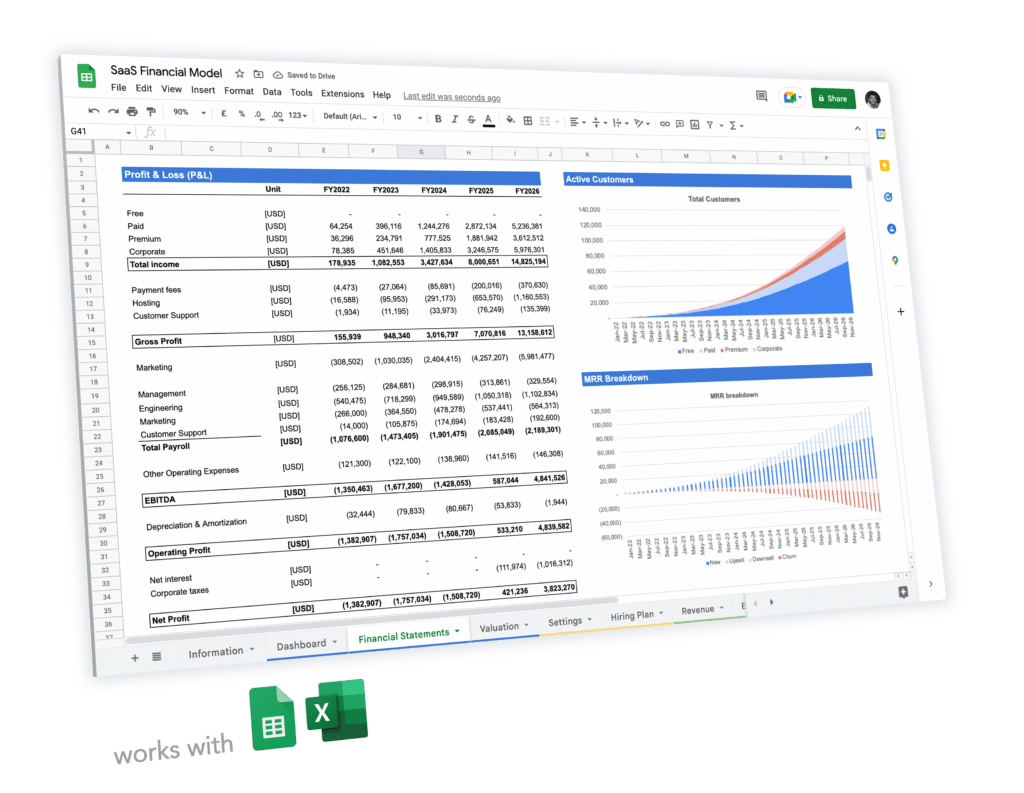Every startup needs a budget. Whether you want to understand what’s your breakeven, your valuation or simply create a budget for your pitch deck or business plan, forecasting your financials is key.
There are a number of options available to you: use a financial model template, a software, hire an expert or do it yourself. In this article we will discuss the latter option: how you can create a rock-solid budget for your startup yourself, whatever business you have.
Note: While we will go through here the 8 steps you should follow to create a budget for any startup, we also have dedicated guides for specific business models (ecommerce, SaaS, etc.). Refer to our blog for more tutorials.
Why does your startup need a budget?
Entrepreneurs and startup founders often create their first budget when pitching investors. Budgets later often end up somewhere idle in a folder, outdated, and are updated for the next funding round.
Yet, budgeting for your startup shouldn’t just be a matter of ticking the box for investors. Instead, budgets should be on top of your ongoing management tasks: keeping an updated monthly budget is essential to make better decisions for your business.
A few examples for creating (or updating) a budget are in order to:
- Assess your breakeven point: when can you realistically expect to be profitable
- Estimate a valuation for your business, even if you are pre-revenue
- Include in your pitch deck or business plan
- Understand how much you need to raise for your fundraising
How to create a great startup budget in 8 steps
Creating financial forecasts for your startup shouldn’t be overly complicated. Even if you have no previous finance experience, with some basic accounting and finance knowledge one can create great budget for any startup. Follow the steps below to build your own.
The first thing you will need to do is to open a blank spreadsheet (Excel or Google Sheet is fine) and follow the 8 steps below.
Remember that your budget will need to be as accurate as possible, to do so you can sources such as market research reports, competitors analysis or even your own financial performance (if any).
In doubt, read our article on the 5 common mistakes you should avoid for your startup business plan.
Step 1. Start from your actuals (if any)
If you have any historical performance to date, start from this to build your budget.
Historical performance can be financials (revenue for example) but not only. If you haven’t yet started to generate revenue and/or revenue is limited and you feel other metrics are more relevant, go from there. For instance, if you have started to build a user list, or email sign-ups, you can also use these numbers to forecast growth, and ultimately revenue.
Only include the key drivers to your business
You don’t necessarily need now to start from your entire profit-and-loss or cash flow statement you would have exported from Xero for instance. Instead, identify what drives the most of your business’ performance: is this the number of customers you have? Is this the commission rate you are charging your customers?
The key drivers will help us estimate your financial forecasts later on. As such, they need to be clearly identified. A few examples of drivers for 3 illustrative businesses are:
- Retail: number of customers, average order value
- Ecommerce: number of visitors, conversion rate, average order value
- SaaS: number of users, churn, average revenue per user
Once you have identified your key drivers, include them as a start to your model. For instance, if you are generating $10,000 sales from 3,000 orders in a given month, your key drivers in that month can be:
- Orders per month: 2,000
- Average order value: $5.0
Step 2. List all startup costs
For new businesses which don’t have yet historical performance, start by listing all the expenses you incur and the assets you need to buy before launching your business.
There are 2 types of startup expenses:
- Assets: one-time purchases of assets such as equipment, machinery, inventory, etc.
- Expenses: any expenses (usually fixed) you incur before you start your business. Do you need to pay for legal fees to incorporate multiple entities? Do you have to pay for a specific license for marketing your products to consumers? Maybe you will need to pay someone to build your website from which you will start acquiring customers later on?
Step 3. Build your revenue model
Before we estimate revenue based on the drivers discussed earlier (step 1), we need to clearly identify what is your revenue model. Surprisingly enough, one business can have multiple revenue models. For a refresher, read our article on the 8 most popular revenue models.
For example, if you sell subscriptions to customers (e.g. gym membership) yet you also sell one-time services (e.g. dedicated sessions with trainers), these should be listed as two separate revenue models as they work differently. The subscription is a function of the number of users you have, multiplied by a recurring monthly fee for instance. In comparison, sessions are a function of a portion of your users, multiplied by another one-time fee.
Once we have identified your revenue model(s), we need to build out revenue for each of them. Using our gym membership above, subscription revenue will be a function of the number you have over time times the recurring fee. For sessions instead, use a percentage of users who pay for a session each month (based on your historical if any) – for instance 5% of total users – and multiply it by the total number of users and the one-time session price.
The gym membership example above help us understand why we need the key drivers we brought up earlier. Revenue projections should never be a plug – a guessed number from you. Instead, revenue is the function of multiple drivers. There are always at least 2 drivers for each revenue model: volume and price.
Note: you might be wondering whether you should be taking into account VAT / sales tax for your revenues projections. VAT impacts your cash flow but doesn’t impact your profit-and-loss so you might not need to include it. For more information, read our article here.
Step 4. Forecast your variable costs
Variable costs are expenses that increase or decrease based on the level of sales and/or another factor (e.g. customers for instance). As such, they can’t just be flat over time, instead their amount will vary based on other parameters of your financial plan.
Common variable costs are:
- Raw materials
- Advertising spend (e.g. paid ads)
- Packaging and shipping costs (ecommerce)
- Transportation
- Corporate taxes
If you have historical performance, use your actuals to forecast variable costs. For example, if you pay $10 in shipping costs in average per order, use the same value for your projections.
Instead, new businesses will have to find information either with industry benchmarks, public sources (cost-per-click for paid ads spending can be found for any keyword on Google Planner for instance) or quotes from potential suppliers.
Step 5. Estimate all your fixed costs
Fixed costs in comparison, are easier to estimate as they remain fixed over the projected period. Common examples are:
- Salaries and benefits (for each employee)
- Website hosting
- Bank fees
- Rent and utilities
Salaries and other payroll expenses often constitute the bulk of fixed costs. In order to accurately forecast salaries you need to estimate the right amount of people you will need over time, and their salaries. Average salaries for specific jobs and geographies can easily be found in industry benchmarks. The number of people your business will need depends on their function: some teams will increase or decrease based on certain metrics such as revenue (sales and customer success teams often grow in line with revenue) whilst others will remain stable (administrative functions e.g. finance).
Read our article on how to build a flexible hiring plan in Excel for your business for more information on how to efficiently forecast salaries expenses as your business grows.
Step 6. Putting it all together
Once you have projected revenue and expenses based on your key drivers, you can now consolidate it all under your profit-and-loss. Subtract all expenses (fixed and variable) as well as startup costs from revenue to get to net profit.
To calculate your cash flow statement, no need to do anything complicated at this stage: simply use your net profit, and subtract any other cash items (i.e. capital expenditures), for instance the startup asset purchases discussed above (step 2).
Step 7. Review and adjust
After having built your projected profit-and-loss and (simplified) cash flow statement, take time to review your estimates. Do they make sense to you? Is there anything surprising in your projections?
The review of your financial forecast should help you determine 2 things:
- Are your projections error-free? It’s easy to get lost in spreadsheet and make mistakes in your calculations.
- Are your projections realistic? Now that you take a step back to look at the big picture (revenue, growth, margins, cash flow), it’s easier to assess whether your projections are unrealistic or not.
In order to build realistic projections for your startup and know how to compare them vs. industry averages, read our articles below:
- How To Use Industry Benchmarks For Your Startup Financial Plan
- How To Build Accurate Financial Projections For Your Startup?
Step 8. Determine the amount you need to raise (if any)
If you are creating a budget for your startup, chances are that your business will be loss making in the first few months or operations. No worries, that’s why startups often raise funding at the beginning before starting operations and/or product development.
If you are looking for funding for your startup, your budget will help you assess how much you should raise.
Disclaimer: raising more is not necessarily better. Knowing exactly how much you need to raise will in fact dramatically increase your chances of raising funding.
To know how to assess how much you should raise for your startup, read our article here.



 5-year pro forma financial model
5-year pro forma financial model 20+ charts and business valuation
20+ charts and business valuation  Free support
Free support